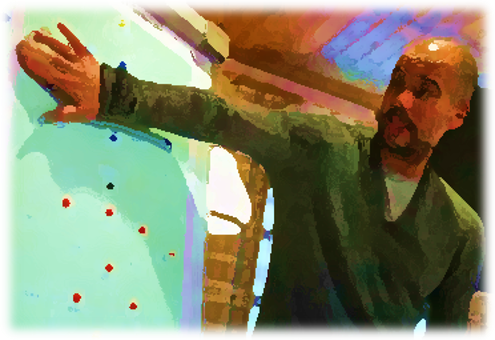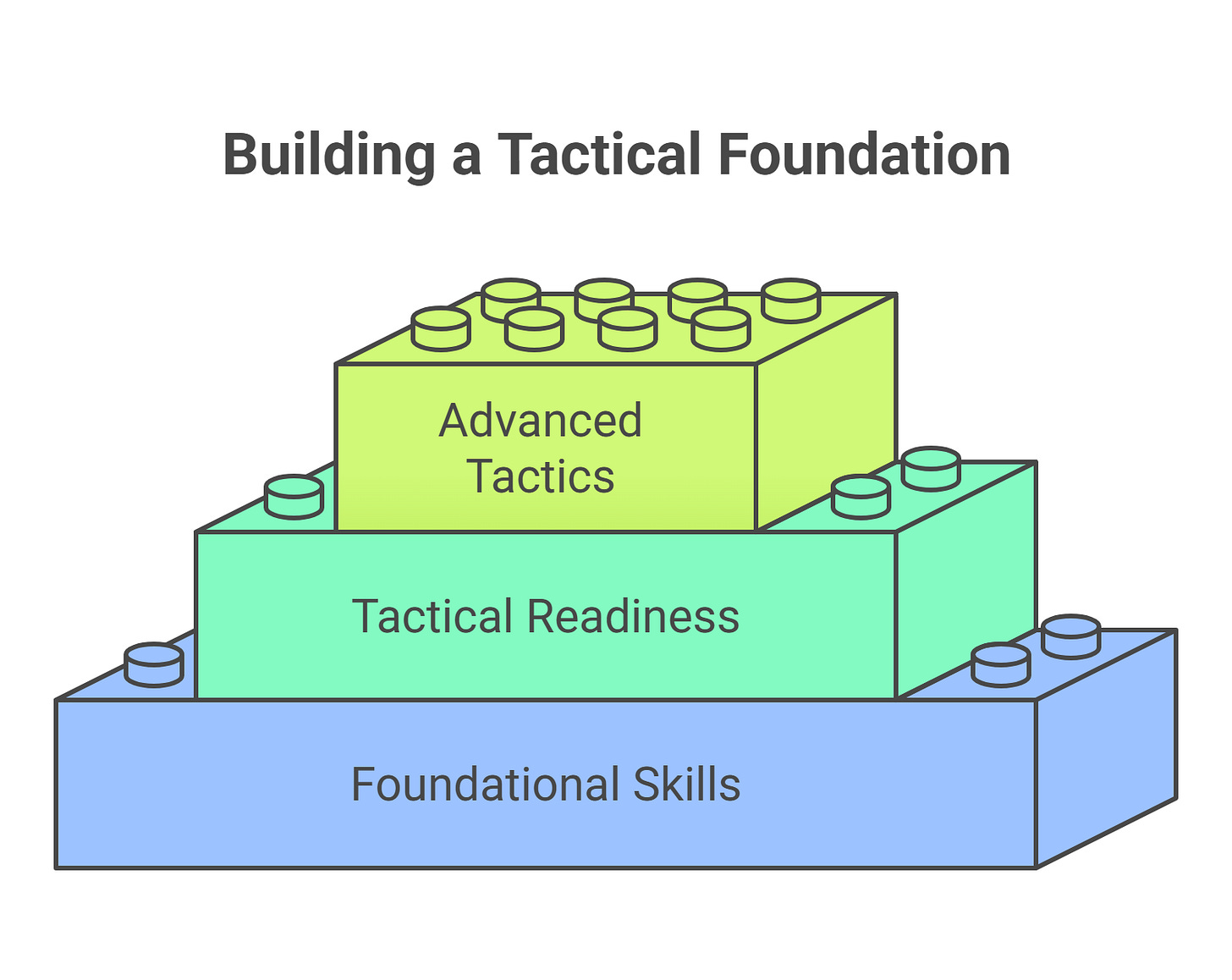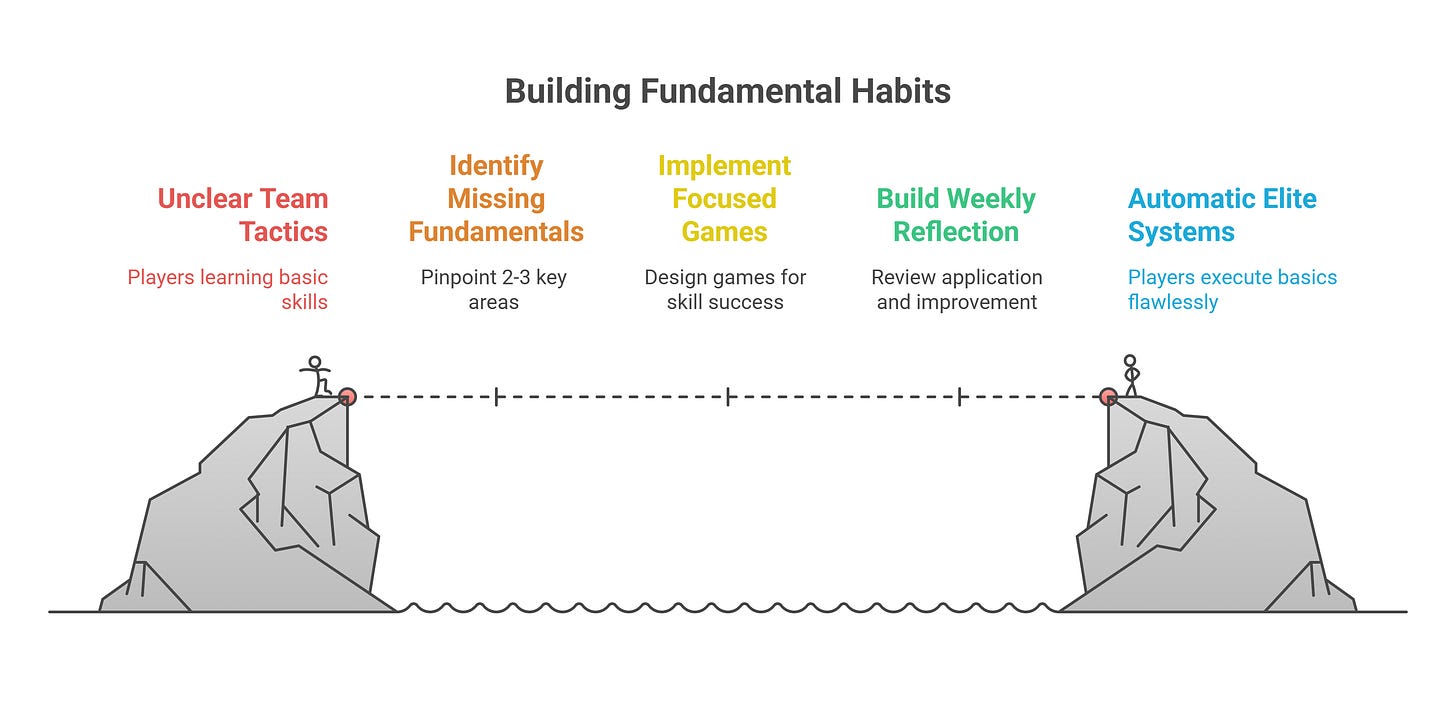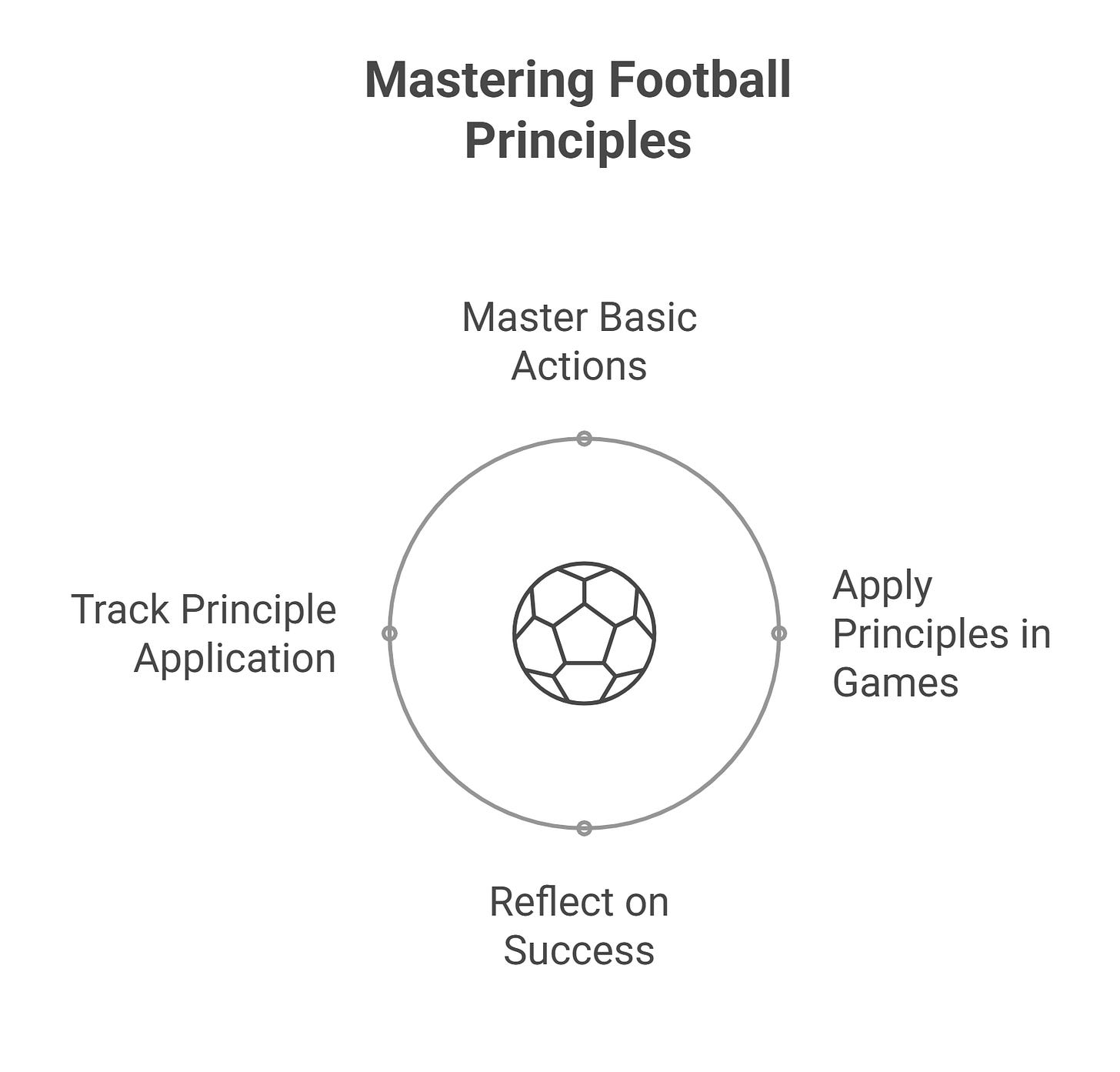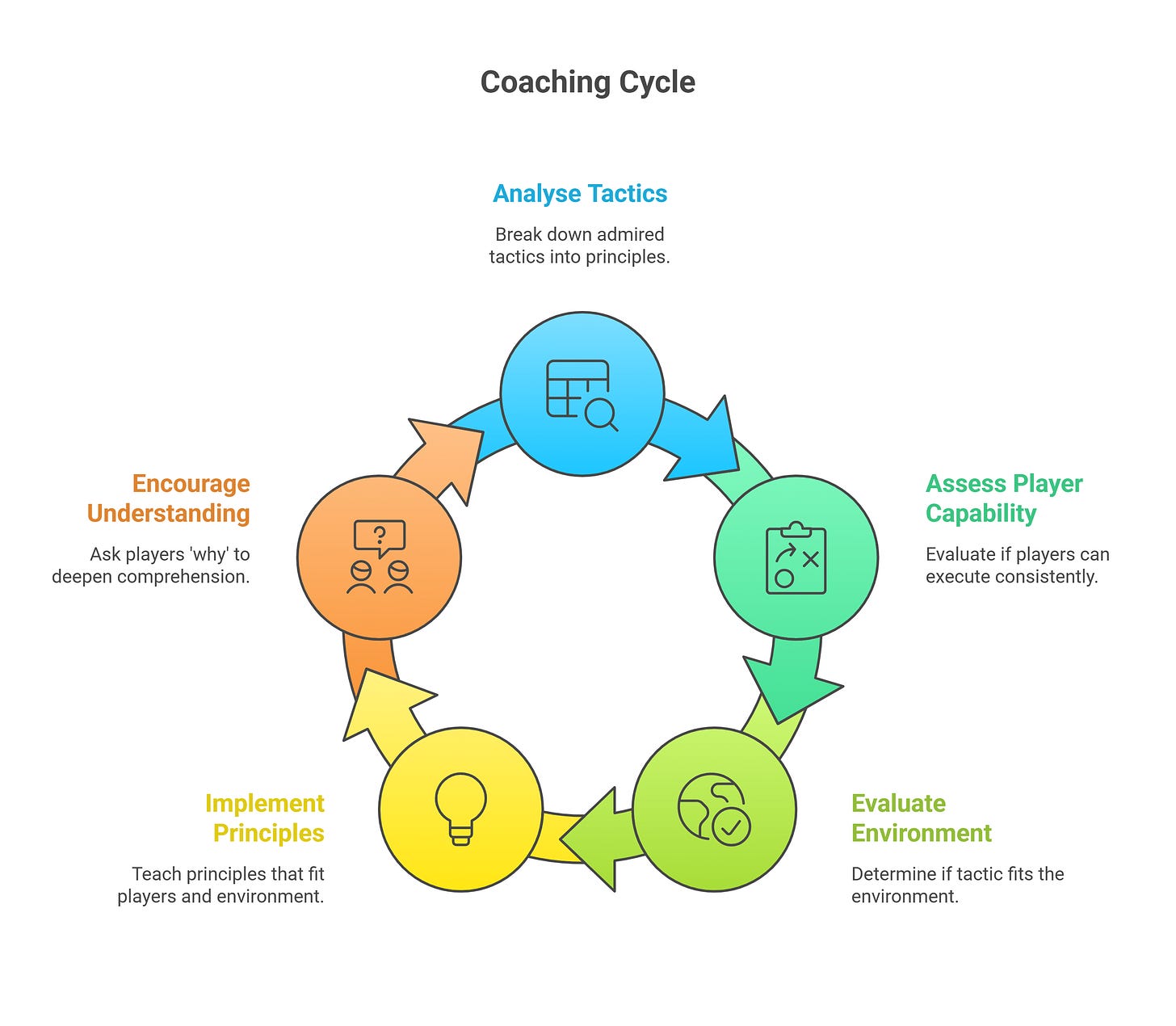Welcome from JustCoachMD. We are happy to have you on board and look forward to providing you with helpful content.
Here is What to Expect:
Coaching Craft: Why copying elite tactics could be breaking your coaching.
Full 60-Minute Practice: Twisting and Turning to Escape Pressure
Don’t coach systems. Coach principles, because principles scale — systems don’t. — Doug Lemov
📝The Coaching Trap: When Tactics Look Good But Don’t Work
In the age of social media tactics, boards and viral analysis threads, it’s easy for coaches to feel pressured to replicate the elite game. We see the 3-2-5s, inverted fullbacks, and pressing traps — and think that’s what next-level coaching looks like.
But beneath every elite tactic lies something far more important: clarity of principle, depth of understanding, and habits forged over time.
This article shares the lessons I learned the hard way — moving from copying systems to coaching solutions, from running practices to designing decisions. If you’ve ever felt like your players “aren’t getting it” or your sessions don’t translate on matchday, this is for you.
⚠️ The Trap of Copying Elite Tactics
We all study the best — Pep, Klopp, Mourinho, Ancelotti — and try to bring their methods into our sessions. False 9s. 3-2-5s. Pressing traps. It looked advanced. It felt impressive. But the football? It was slow. Hesitant. Confused.
Why? Because I had skipped the fundamentals. My players weren’t ready for complex shapes — they needed the foundational skills that made those systems work at the elite level. I was layering tactics on top of uncertainty.
📌 What I learned: Without a strong foundation, even the best ideas collapse.
🛠️ Tips & Action Steps:
Before copying a tactic, ask: Are my players ready for this?
Focus your week around one key game moment (e.g. building from the back, defending transitions).
Teach principles first — structure comes second.
🧠 Missing the Context of Mastery
Our team trained three times a week. Some players were still learning to scan, stay compact, or press with purpose. Yet I was throwing advanced tactics at them, assuming that more complexity meant more progress.
The truth? Elite systems work because the basics are automatic. Top players don’t hesitate because they’ve repeated those habits thousands of times.
📌 Why it matters: Without clarity, players don’t play faster — they just hesitate longer.
🛠️ Tips & Action Steps:
Identify 2–3 missing fundamentals in your team (e.g. scanning, pressing triggers).
Use games that require these to succeed (e.g. only score if you scan before receiving).
Build reflection into your week: Where did we apply our principles?
The sweet spot of learning is where the task is just beyond the player’s current ability — not too easy, not too hard. — Dr. Mark Williams
🧱 Principles Over Patterns
Before any elite tactic, players must master the actions that support it:
Play forward fast 🚀
Take space with confidence 🔓
Press with structure 🔁
React instinctively in transition ⚡
When we copy tactics without instilling these principles, the result is surface-level structure with no substance underneath.
📌 How to change it: Shift your lens. Don’t plan drills — plan decisions. Don’t script patterns — teach players to solve problems.
🛠️ Tips & Action Steps:
Design small-sided games with specific rules (e.g. must break a line in 5 seconds).
Ask players: What principle helped us succeed in that moment?
Track how often players apply a principle, not how often a drill works.
🧤 Building with Behaviour’s
You want to build out from the back? Don’t start with a 4-3-3 diagram. Start with behaviours.
Ask:
Do players scan and shape to play forward?
Can the team stay calm under pressure?
Do all players look to receive on the half-turn?
If the answers are unclear, your formation won’t fix it. Build these habits before adding structure.
📌 How to coach it: Use a game where progression only counts after playing through the goalkeeper, and reward players who receive on the half-turn.
🛠️ Tips & Action Steps:
Freeze play and ask: What did you see? Could you play forward?
Add scanning or shaping constraints (e.g. no pass forward unless scanned first).
Celebrate smart decisions, not just technical outcomes.
👣 Pressing Isn’t About Running — It’s About Reading
You want your team to press like Liverpool? Don’t begin with a diagram. Begin with recognition.
Ask:
Do your players understand pressing triggers (lack of space, bad touch, backwards pass, player turns back)?
Do they communicate with each other? (Where to force the play, who is going to press?)
Can they recover quickly when the press is broken? (Marking, tracking runners, covering space)
📌 Why it works: Players don’t need pressing patterns — they need a shared understanding of when and why to press.
🛠️ Tips & Action Steps:
Use games with pressing zones or bonus points for regains in key areas.
Define 2–3 pressing triggers, and use them in session reviews.
Ask players to lead: “What’s the cue? Who goes next?”
🎭➡️🎯 From Choreography to Choice
A turning point for me: I stopped designing patterns and started designing decisions.
Instead of scripting movement, I’d choose a game moment (e.g. win the ball) and ask:
What do I want players to notice?
What choices should they have?
How do I make those choices part of the activity?
📌 The impact: Players went from passive participants to active decision-makers. And the game looked more real — because it was.
🛠️ Tips & Action Steps:
Start every session by defining the key decision: “When you win the ball here, what’s next?”
Use conditions that force choice (e.g. must play forward or wide within 3 seconds).
Debrief with: What were your options? What would you do differently next time?
🧭 Every Session Linked to a Principle
Now, every session I run connects directly to a principle. I’m not just planning exercises — I’m reinforcing ideas that matter on matchday.
Some examples:
Forward Thinking: Play with the intent to progress
Intense Defending: Don’t wait — react quickly, press intensely, recover at speed
Bravery on the Ball: Stay on the ball, protect and shield it, connect and combine, play through pressure.
📌 Why this works: When principles guide the session, players understand the purpose. And that builds confidence and clarity.
🛠️ Tips & Action Steps:
Open every session by stating the principle: “Today we’re working on forward mentality.”
Design a win condition that depends on that principle (e.g. score only after breaking a line).
End sessions with guided questions: “How did we show that principle today?”
A coach’s job isn’t to install complexity, it’s to remove confusion. — Stuart Armstrong
🔍 Stop Chasing Systems. Start Coaching Understanding
Trendy tactics are just the surface. Behind every system is a set of behaviours, principles, and shared understanding.
So before you try to replicate Man City’s midfield rotation or Liverpool’s counterpressing, ask:
What principle does this tactic rely on?
Can my players execute it consistently?
Does it make sense in my environment?
📌 The shift: Instead of copying what’s popular, coach what’s possible.
🛠️ Tips & Action Steps:
Break down any tactic you admire into 1–2 teachable principles.
Only use what fits your players’ learning level and weekly rhythm.
Ask players why during training — deeper understanding leads to better decisions.
🧩 Final Thoughts
It’s easy to be drawn to what’s flashy: the rotations, the 3-box midfields, the high traps. But if your players don’t understand the principles behind the tactic, it won’t stick.
Coaching isn’t about sounding clever. It’s about making the game clearer for your players, your team, and your context. That means moving beyond copy-paste tactics and teaching decisions, habits, and principles that last.
Start simple. Stay consistent. And always connect what you coach to what the game demands.
The game is the teacher. The more your sessions look like football, the more your players will understand football. — Mark Upton
The Practices:
1v1 Twisting and Turning
⚽️ Created On: @tacticalPad
Aim:
Practice twisting and turning to escape pressure
Set-Up:
20 by 20 square with multiple coned scoring gates. Half the gates are marked in red, and the other half the gates are marked in black
👕Teams: 🔴’s vs ⚫️’s
How to Play:
⚫️’s start in possession of the ball. They must dribble through as many black coned gates as possible before the 🔴 player tackles them.
When the 🔴 regains the ball, they try to dribble through as many red coned gates as they can.
Players keep the score, and a round of games lasts 60 seconds. After a round of games, players switch partners.
🚧 Constraints:
🏆Reward: If a player dribbles through three gates in a row without losing the ball, they get a bonus point.
👨🏫 Review: Player’s ability to play with disguise to hide their intention
🚫 Restriction: Once the attacker has scored by dribbling through a gate, they must score in a different gate before they can go back to the original gate they scored in.
1v1 Shooting at Goal | Recovery Sprints
⚽️ Created On: @TacticalPad
Aim:
Practice running with the ball toward the goal and fast reactions to defend.
Set-Up:
30 by 30 pitch with 2 x large goals offset by around 5 yards and a 🟢 (GK) in each goal. Split the pitch in half to create 2 x lanes.
The ⚫️’s start at the top of one lane with a goal and 🟢 (GK) opposite them, and the 🔴’s start at the top of the other lane, also with a goal and 🟢 (GK) opposite.
👕Teams: 🔴’s vs ⚫️’s plus 🟢 (GKs)
How to Play:
The 🔴 starts the attack and runs the ball toward the goal. They take their shot, then immediately defend the ⚫️ who is triggered to start their attack by the 🔴’s shot.
The pattern for the players to remember is to attack the goal opposite, defend the opponent’s attack, and then leave the pitch.
If the defender wins the ball, they should dribble over the endline of the pitch (at the side of where any attacker is standing)
🚧 Constraints:
🏆Reward: First team to score 10 goals wins the round
👨🏫 Review: Size of touches when bearing down on the goal and the quality of the finish.
🚫 Restriction: Players have 5 touches to score, or they must defend.
Small Sided Game | 4v4 | Gates and Goals
⚽️ Created On: @TacticalPad
Aim:
Develop decision making of when to pass, dribble or secure the ball.
Set-Up:
On a 30 by 30 playing area, place multiple coned gates, 3 x red and 3 x black coned gates. Add a mini goal on each side of the pitch. Offset the mini goals so players cannot just block them.
👕Teams: ⚫️’s and are attacking the mini goal vs 🔴’s attacking the single larger goal.
How to Play:
Teams have to compete for possession. They have to unlock the opportunity to score by dribbling through a red-coned gate or passing through a black coned gate.
If their opponent wins the ball, they have the same aim. They must dribble or pass through a gate before scoring in any goal.
Gradually build up the difficulty where players must achieve both the dribble through a gate and pass through a gate before scoring
🚧 Constraints:
🏆Reward: Reward a goal for the number of gates dribbled or passed through before scoring (if a team dribbles/passes through three gates and then scores=3 goals).
👨🏫 Review: The decision to dribble, pass or secure possession.
🚫 Restriction: Each team is assigned a pair of goals to attack and defend.
Football is a game of decisions. Our job is to create environments where players learn to choose, not just follow instructions. — Johan Cruyff
I send this email weekly. If you would like to receive it, why not join a community of like-minded people who love the game of football?
Enjoyed reading this post, feel free to share it with your friends! Or click the button below so more people can discover us.





